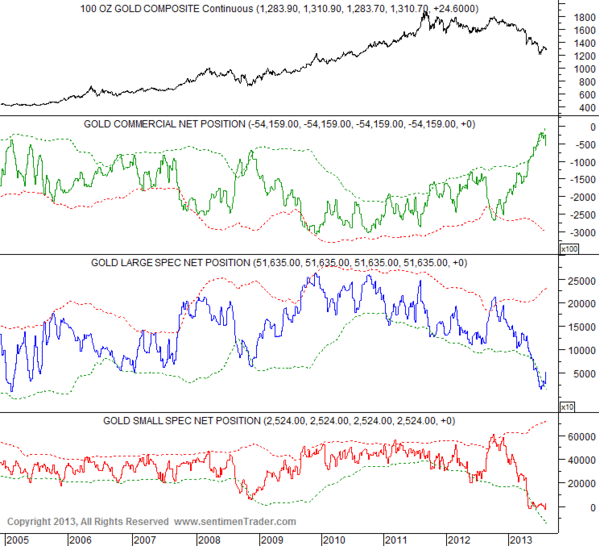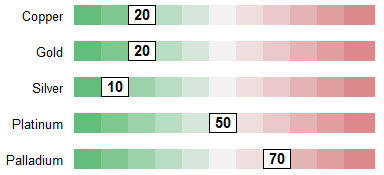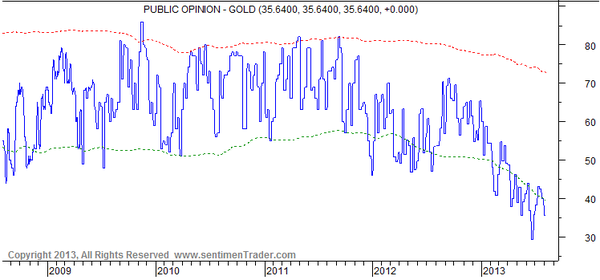
The speculative community has crushed the gold and silver price in the second quarter of this year. From a short term price perspective, the outlook for gold and silver is not too bright. On the other hand, investors who own the metal in PHYSICAL form (acting as their own central bank) have an ideal hedge against the increasing counterparty risk.
This week’s COT report (first chart gold’s report) provides an insight in the outlook of the precious metals. The COT report shows the futures positions of commercials and speculators. Their positions are important because those “paper markets” (COMEX and LBMA as the most significant ones) continue to dominate the price setting. Speculators include hedge funds in the “managed money” category in the reports.

The chart shows that large speculators keep on increasing their net short position in gold while the commercials keep extending their net long position. Commercials are known for seducing speculators in one direction while simultaneously changing their own positions. Nevertheless, speculators have been in control over the past months with aggressive short bets. Besides, some analysts argue that the rise in long positions of commercials is due to hedging of gold miners, a common practice during gold’s bear market in the 90’s. It would imply that sentiment among speculators will be an important driver of precious metals prices going forward.
According to the latest Sentimentrader data, the sentiment vis-à-vis the metals remains at extreme levels. From a contrarian point of view, it could be interpreted as positive. But given the recent correlation between sentiment and prices, it is likely a bearish factor short and mid-term.


What is at the basis of this sentiment? In order to understand the arguments of the bears, it suffices to turn on a mainstream media channel. A recent commentary from a Wall Street pro on CNBC, Mr. Scaramucci, showed four reasons why hedge funds could continue to push the gold (and silver) price lower.
When analyzing the bearish arguments, we figured that every argument can basically be reversed to become a valid counter-argument. Why? In our opinion, it all depends on the time horizon and the fundamental difference between investing and trading. The following high level analysis makes our point clear.
Please note that our point is not to criticize trading. We just point to the fundamental difference between trading and investing. Traders do not necessarily take decisions based on fundamental grounds. Also, traders have a benefit in the fractional and leveraged system, which is the reason why they will never mention the monetary benefits of physical precious metals.
Bearish argument 1: Central bankers are exercising caution
The first point is related to inflation. It touches the most known benefit of gold, which is a hedge against inflation. The following quote comes from the CNBC interview:
“There’s a lot of very wealthy people that are going to own gold as a defensive hedge for what they’re fearing is that whole Weimar Republic thing, where either the Europeans or the United States aggressively prints money, where the multiplier effect kicks in on the banking side, and you get this out-of-control inflation,” Scaramucci said, referring to hyperinflation that occurred under the German democratic system in place between 1919 and 1933.
But Scaramucci says these gold bugs just aren’t doing their research. “If you read the minutes from the Federal Reserve, or if you look at the essays that Ben Bernanke just recently published, you will discover that your central bankers, particularly in the United States, understand this issue very well. And that’s one of the main reasons that gold has not worked in this environment.” The Fed minutes make clear that the Fed is keeping a close eye on inflation, and is keeping risk factors in mind. For instance, the latest Fed meeting minutes, from the July 18-19 meeting, note: “Although the staff saw the outlook for inflation as uncertain, the risks were viewed as balance and not particularly high.”
The obvious counter-argument?
The underlying assumption in the above statement is that the US central bank is kind of omnipotent. But what if that is not true and their policy will not bring the desired results? After all, they cannot justify their policy based on empirical results as the current money experiment is unprecedented in its scope and scale.
The fact is that the US is currently exporting their (monetary) inflation. Lots of the newly created dollars end up at foreign central banks rendering abroad currencies weaker. That is why the dollar is increasingly bypassed through trading agreement particularly by the BRICS (as we reported here, here, and here). Going forward, one should not exclude a scenario in which inflation stays within the US and price inflation picks up fast.
True, it is not visible on the horizon yet. But it is a looming risk which can materialize rather fast. History learns that inflation remains invisible longer than most expect but picks up faster than expected.
Bearish argument 2: Deflation has become a risk
The second point is related to disinflationary signs from the global economy which could, ultimately, lead to deflation. From the interview:
“What’s happening now is the specter of deflation is way, way, way more fearful to the central banking community than inflation,” Scaramucci said, “and gold typically works when there’s a devaluation of currency, or inflation.” As the Federal Open Market Committee noted in its July 31 statement: “inflation persistently below its 2 percent objective could pose risks to economic performance.” “In a deflation economy,” Scaramucci said, “gold is not going to work.”
The obvious counter-argument?
Central banks are scared to death about deflation. Japan’s fear for deflation resulted in the biggest monetary stimulus in history, beating helicopter Ben. What if central bank’s policies get out of control in their attempt to defeat deflation?
From another point of view, let’s assume that Western central banks will allow deflation. In such a scenario, gold will go down, but history has shown that it goes down to a LESSER extent than other assets (see Exeter’s pyramid). In such an environment, physical gold offers protection in a decline of purchasing power.
Bearish argument 3: The Fed won’t sell its bonds
The third point is related to the risk that the bond bubble will burst. From the interview:
“People are buying gold because they predict there’s a bond bubble,” he said. “And they predict that, at some point, the Fed is going to shed their $3.9 trillion balance sheet. But that’s not going to happen either.” He believes this incentive for the Fed to sell its bonds simply isn’t there. “The Fed’s duration on its balance sheet is only about seven years,” Scaramucci said. But “they’re a 100-year-old institution, they live inside a 237-year-old country, and there’s no reason to shed that portfolio. They’ll just let their portfolio unwind. And so the prediction here will be that gold prices will languish.”
The obvious counter-argument?
The US Fed is the most important buyer of domestic bonds. What if the market loses trust and pushes yields much higher, to such an extent that the Fed cannot control their own interventions? Higher bond yields (and hence lower bond prices) started to “spiral out of control” since May of this year. The US Fed’s chairman reaction on that was: “it got us puzzled.”
Longer term, our belief is that distorted markets because of central bank intervention will react violently. The precious metals selloff this year was due to the investing community’s perception of relative asset performance. Precious metals were simply the first shot across the board. With looming inflation and dollar debasement, precious metals will be back in favor longer term. That’s when a major price rise will be likely, at a comparable pace as the recent decline. Likewise, we expect other assets to be sold off hard as soon as they will fall out of grace.
Bearish argument 4: Economic growth would hurt gold
The fourth point is related to additional monetary easing as a response on economic growth.
To Scaramucci, holding gold has become a lose-lose proposition. “If the economy picks up, rates pick up, that’s bad for gold. If the economy doesn’t pick up, the Fed is going to be in exactly the position that it’s in now, which is effectively QE but no real money creation.” Simply put, while people thought quantitative easing would create gold-boosting mega-inflation, that simply hasn’t happened. So now, the risk remains to the downside—because rising rates make gold, which does not produce yield, even less attractive in comparison to bonds.
The obvious counter-argument?
On one hand, the gold price has risen between 2001 and 2008 without quantitative easing and with much higher interest rates as today. On the other hand, quantitative easing is about currency debasement, which is happening all around the world right now. The epicenter is in Japan and the US. The dollar is the best of all bad currencies.
The rationale for investing in (physical) gold is related to the monetary protection against the debasement of money.
Also, every marginal unit of economic growth needs an increasing number of units of debt. The effectiveness of debt is at all time lows. So more debt is needed to keep the economy going, not growing. That points to a continuation of the dilution of the value of money.
Conclusion
While the bearish arguments do make sense from a trader’s point of view in the short to mid-term, they do not take into account the fundamental monetary benefits of gold and the violent message of heavily distorted markets. The monetary crisis and financial turmoil in a centrally managed economy are starting to show their ugly head. Jim Rickards describes in Currency Wars how the previous two currency wars took 10 to 15 years to play out. If history is any guidance, the monetary crisis will be the most important fundamental driver for gold. But that’s not what is top of mind of traders, at least not yet.
About GoldSilverWorlds.com
A couple of years ago, we discovered something was fundamentally wrong in our economy. Between the spring of 2000 and 2009, we noticed a series of extreme but also conflicting events. For example, the two decade bull market in the global stock markets which should have ended in 2000, should have been replaced by a new wealth cycle. Instead, in 2007 a new peak was reached in the stock market, but in a non-natural way. The type of implosion that followed in 2008/2009, wasn’t a natural type of event. At the same time, while the price of several commodities have been increasing in a steady way, others showed literally price explosions. One of those commodities, gold, revealed such a steady and robust long term price chart, that it raised a very natural question: ”What is such a robust price chart signaling?”
Our personal and extended research showed that we were experiencing a new wealth cycle. In the last two decades of the 20th century, paper financial assets were the main source of wealth creation. But as it goes with all cycles in this world, the death of one cycle goes hand in hand with the birth of a new one. So we discovered that the first years of the 21st century brought about the birth of a wealth cycle that was centered around hard assets: gold, silver, grains, sugar, potash, rare earths, etc.
Interestingly, the paper financial world was still rising at the same time. In the light of the theory of wealth cycles, we thought that was not really possible …. until we understood the role of the governments. They were apparently not very happy with the ongoing evolution. A paradigm based on financial paper assets is the kind of world they like because they can control it. The real assets based paradigm by contrast, implies a less significant role for governments and Central Banks. It’s all about power and control, even if it means they need to fight a natural ongoing trend. That insight marked a milestone in our view on the world. We weren’t aware it was THAT bad.
By researching the different types of commodities, we discovered that gold and silver had some special values. The most striking one, is integrity! Gold cannot lie, is what we wrote about it. Furthermore, it’s the only asset that can store wealth in a universal way, outside the financial system. During the exceptional implosion of the financial world in 2008 / 2009, we understood that gold was the ultimate store of value: despite it’s price decrease, it was still protecting wealth. The safe haven characteristic of precious metals is historically an important one, although it seems that the world forgot it over the past few decades.
By talking to ordinary people like friends and families, we discovered that most of us consider holding gold or silver as something “exotic”, something “mythical”. That was the final trigger for the birth of GoldSilverWorlds. As we became convinced that gold and silver were decisively going to continue their uptrend and that most people were not aware of the values of the precious metals, we wanted to contribute in a positive way to our society. The ultimate message of gold and silver being “safe havens” which protect our wealth, is a fundamental one for everyone of us to understand. It becomes even more important in a world where governments, central planners and banks will do everything they can to maintain their power. Their extremely dangerous monetary policies result in immense amounts of debts, that sooner rather than later will result in wealth destruction. The longer we wait, the worse the effects. Ordinary and hard working people will pay part of the bill as well. This attitude is simply immoral.
GoldSilverWorlds has the intention to spread the message about the real benefits of gold and silver in a simple way that everyone of us can understand. GoldSilverWorlds helps people understand how to invest their personal or professional wealth, where they can do so and what to avoid when doing so. Those are messages that are not told by mainstream media, sadly enough. Because of the internet, we can help each other as indidivuals, so let’s make use of it !












